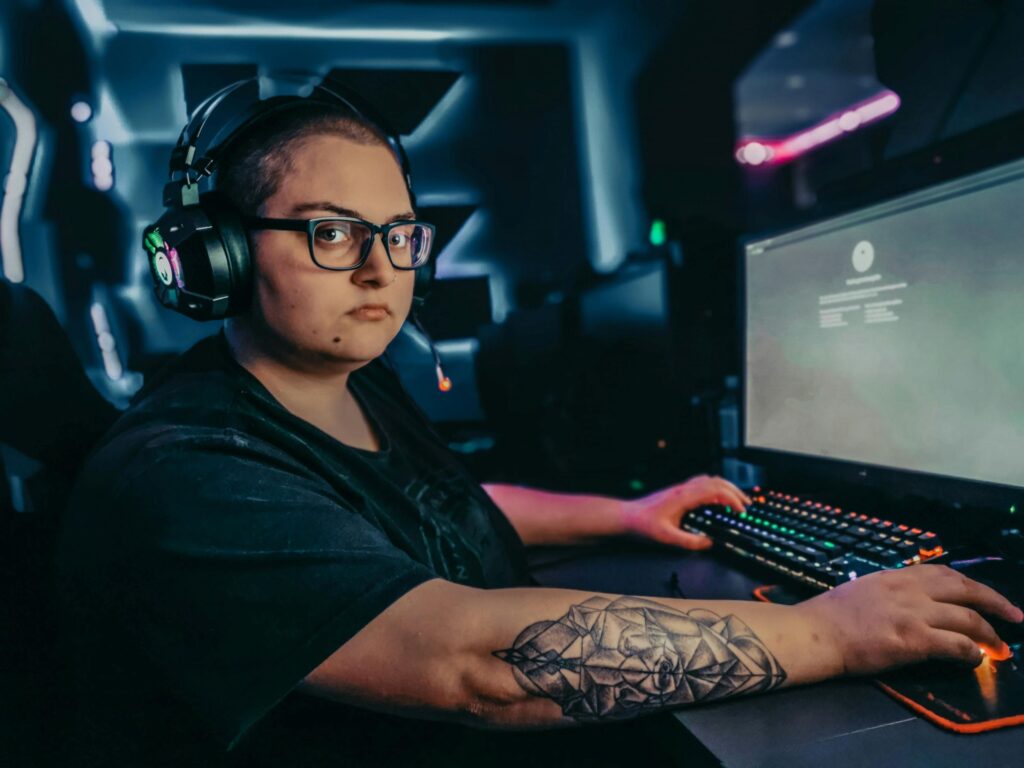Key takeaways
- Video game designers conceptualize, design, and develop interactive gaming experiences.
- Within the video game design industry, there are various specialized roles such as gameplay designers, narrative designers, and game system designers.
- Due to the increasing popularity of video game design, competition for jobs in the field has become more intense.
- Graduates with video game design degrees can find employment in media agencies, entertainment companies, and even freelance roles.
- The global gaming market is experiencing major growth, with a projected 46.43% increase in revenue from 2024 to 2029.
- Joining organizations like the International Game Developers Association or Entertainment Software Association provide networking opportunities, mentorship, and industry insights.
If you want to gain a competitive edge in the field of game design, you have come to the right place. In this career guide, we discuss the career prospects for video game designers, list essential skills and education they must acquire to succeed in the field, and provide insight into job market trends.
What does a video game designer do?

Game designers are crucial to the game development process, shaping the game’s concept, user experience, and gameplay mechanics. They create immersive experiences through visuals and audio, making games more engaging. By blending creativity and technical skills, game designers bring game worlds to life, collaborating with other professionals to deliver captivating gaming experiences.
Game designer jobs – responsibilities and tasks
The duties and responsibilities are usually listed in the game designer job descriptions and vary based on the organization’s requirements. Keep in mind that game designing is not a one-person job, but a team effort, so the designing responsibilities and tasks are shared among team members.
Video game designer job responsibilities encompass various stages of the design process, including:
Conceptualization and game design
Curating the game’s concept, storyline, characters, story, and objectives are the essential video game designer job responsibilities. Additionally, they are tasked with the responsibility to set the game apart by brainstorming creative and innovative ideas.
Gameplay mechanics and systems
Defining the core gameplay mechanics, such as character movement, combat rules, puzzles, and interactions is also a designer’s responsibility. Responsibilities also include balancing the game’s difficulty to ensure it remains engaging without becoming frustrating. Designers also create progression systems, including character advancement, item acquisition, and rewards, to keep players motivated.
Level and environment design
Game designers create maps, and environmental layouts, determining the placement of interactive objects such as objects, collectibles, enemies, and hurdles. Level and environment designers determine the level of difficulty and ensure a balance between intense action sequences and some relaxed scenarios.
User Experience (UX) and User Interface (UI)
Designers responsible for UX and UI create intuitive, visually appealing, and user-friendly interfaces. They could be responsible for creating elements like menus, HUD elements, and interactive components. They also focus on enhancing the overall player experience by optimizing interactions.
Storytelling
Responsibilities include creating storytelling elements, including dialogues, character development, plot progression, branching narratives, and dialogue trees to allow players to make choices that impact the story’s outcome.
Quality assurance
Prior to the launch, video game designers are involved in creating mockups, prototypes, and playtesting activities for quality assurance. They gather feedback from players and make necessary adjustments to improve overall performance.
What are the essential skills for video game designers?

To gain a competitive edge as an applicant for varying game designer jobs, one must possess the ideal combination of soft and hard skills sought after in the industry. These can be developed via a formal education in the field of game design and development.
Soft skills or transferable skills
Soft skills refer to personal attributes, interpersonal skills, and communication abilities that are essential for success in game designer jobs. These include:
- Communication – Game designers will need to communicate among team members, and with users during playtesting phase. They must be able to listen to, understand, and incorporate feedback.
- Collaboration – Game designing is a comprehensive process requiring collaborative effort across multiple channels. A designer may be required to work with interdisciplinary teams including sound designers, programmers, and artists.
- Adaptability – game designing and creation is an extensive and evolving process. A designer must be able to adapt to the changes and take it all in stride.
Hard skills or technical skills
Hard skills are specific, teachable abilities that are often measurable and can be acquired through education, training, or experience. The ideal way to build technical abilities is via a bachelor’s degree in video game design.
- Programming – Programming languages such as C++ and Java Script are two of the most widely used.
- UX/UI development – User interface and experience development is a complex yet essential component of game design. Formal training in it combined with design instincts is ideal for aspiring game designers.
- Prototyping – Designers must have knowledge of prototyping platforms such as Unreal Engine or Unity 3D and prototyping standards.
- Art Software – For mind mapping, flowcharting, character creation and design knowledge of art software like Adobe Photoshop and Illustrator is essential.
- Bug trackers – Jira is the most popular bug tracker in the industry currently.
- Scripting languages – Scripting languages allow designers to code and encrypt the game to enhance cybersecurity. Knowledge of scripting languages also opens career opportunities in cybersecurity.
What career opportunities are available to video game designers?
The demand for video game designers has skyrocketed. While competition is fierce, the growing game market and impressive sales figures offer exciting opportunities. For dedicated individuals with the necessary skills and knowledge, there are ample jobs in game design and not just in the gaming industry.
Typical employers
The big 3 in the video gaming industry are Microsoft, Nintendo, and Sony. While these three dominate the gaming industry, they are not the only employers aspiring video game designers can look towards. Many types of companies such as startups, non-profit organizations, as well as private and public corporations employ video game designers.
Job applicants can explore jobs in a variety of companies including game development studios, media agencies, and entertainment companies. Some US employers offering jobs for game designers include:
- Netflix
- Meta
- Activision
- Kurz
- Cliffhanger Games
- Hitapps
Additionally, designers can also look for freelance game designer jobs. However, one needs a strong portfolio and a demonstrated track record in the game design industry.
Common video game designer jobs
Here are some of the most common video game designer job descriptions, roles and responsibilities:
Gameplay designer
Job responsibilities of a video gameplay designer include coming up with the concept of the game, including its genre, setting, and objectives. They are also tasked with the responsibility of designing game mechanics including character movements and arch, balancing the gameplay to ensure it is not too difficult or too easy, and testing and revising the final product based on feedback.
Narrative designer
Even though crafting a compelling narrative falls under the generic game designer job description, the complex task is often allotted to a talented individual who specializes in storytelling and narrative design. They write the dialogues and script, create scenes, work with costume designers, and other teams to create a multifaceted gaming world.
Game system designer
A game system designer creates the underlying rules, mechanics, and systems that govern a video game. They define how players interact with the game world, including character movement, combat, puzzles, and other gameplay elements. Additionally, they work closely with the gameplay and narrative designer to ensure theme coherence and game balance.
Level designer
Level designing is an essential part of a game designer job description. Individuals specializing in level design are responsible for creating a natural progression in the game in terms of difficulty level and story progression. They design the layout, obstacles, enemies, and other elements that players will encounter at each level.
Additionally, they focus on creating a well-paced user experience to ensure players are not overwhelmed with challenges and can enjoy relaxed periods as well.
Sound designer
Sound design does not essentially fall within a video game designer job description. However, it is an important part of the game development process and an available specialization in a bachelor’s degree in game design. They create audio effects including character voices, sound effects such as battle cries, and ambient sounds, which enable an immersive user experience.
UX/UI designer
A game UX/UI designer is responsible for creating the user interface and user experience of a video game. They focus on ensuring that the game is easy to navigate, visually appealing, and enjoyable for players to interact with. Therefore, they should possess knowledge of design tools such as Adobe Photoshop, Figma, Sketch, InVision, and Illustrator.
Additionally, they should have knowledge of game development tools, prototyping, and testing tools. Even though these may not be listed within the job description, a working knowledge of the tools can help you get a competitive edge.
Video game designer’s average salary
The average salary for a video game designer is around $71,000 as per PayScale. Senior-level designers can expect to earn up to $113,000 per year. According to the platform, the majority of employed professionals are satisfied with their job. Additional perks they enjoy include:
| Medical benefits | Dental benefits | Vision |
| 81% employees | 72% employees | 66% employees |
The median salary for different jobs for game designers is as follows as sourced through PayScale:
| Jobs for game designers | Average salary |
| Writing procedures and documentation | $69,538 |
| Element design | $73,981 |
| User experience designing | $66,232 |
| Unreal Engine expert (prototype testing) | $70,784 |
Gaming industry trends
The worldwide gaming market’s 2022 annual revenue was estimated to be $347 billion as per a report by Statista. A further 46.43% growth is expected in the video game industry between the years 2024 to 2029. Moreover, an in-depth report suggests that the high growth potential shares a major chunk with cloud gaming technology.
However, if the current industry progression is to be taken into account, it may yet be a few years before cloud gaming takes the video gaming market by storm. Nonetheless, job opportunities are there as cloud gaming technologies and services enter mainstream media.
The report highlights the Virtual gaming market as another high-potential market in the next 10 years. Currently, the VR gaming revenue is expected to cross $3.2 billion. Experts are basing the projection on the heavy investment in VR equipment development by major companies.
PlayStation’s VR2 launched in February 2023 and sold nearly 600,000 units in the first six weeks after the launch. Additionally, Chinese gaming companies such as Genshin Impact Maker, and Fantasy Developer Hotta Studio are promoting online multiplayer games. Western video game production companies are investing heavily in online multiplayer games to compete with Chinese competitors for a bigger slice of the market.
Alternate job opportunities
Graduates with a bachelor’s degree in video game design are equipped with a range of transferrable skills, technical capabilities, and soft skills that make them suitable for a variety of job roles.
These include:
| Job title | Median annual wage |
| Computer Programmer | Median annual wage $ 99,700 |
| Digital Designers | Median annual wage $98,540 |
| Video Game Producer | Median annual wage $123,084 |
| Multimedia artists and animators | Median annual wage $99,060 |
However, if you are passionate about pursuing game design, then jobs for game designers are ideal for you. You can pick a particular niche you enjoy curating and apply for a job that allows you to unleash your passion and creativity in the field.
How to find video game designing jobs?

The best way to enter the video game designer job market is to be well-connected within the industry. This will allow you to engage with like-minded peers and also provide access to industry leaders and experts.
Through mentorship opportunities, creative workshops, internship opportunities, and boot camps, you can enter the circle of video game designers. Moreover, college job fairs and job placement programs provide students access to career opportunities in the field. Thus, careful consideration is essential when choosing a college for a game design degree.
Additionally, you can explore the following professional organizations which offer support and opportunities to their members.
- International Game Developers Association
- Entertainment Software Association
- IEEE Task Force on Player Satisfaction Modeling
- Indie Game Developer Network
- Digital Games Research Association
- Academy of Interactive Arts and Sciences
Participation with members of the above-mentioned organizations not only opens doors to many professional opportunities but also broadens an individual’s horizon. Lastly, you can explore many online job hunt platforms such as LinkedIn, Indeed, Glassdoor, Zippia, and so on. Moreover, you can search for remote work opportunities through platforms such as Upwork.
Complete list of colleges for a video game designer degree
Here are some of the best colleges in the US offering a bachelor’s degree in video game design.
| College Name | Program | Acceptance rate | Tuition |
| DePaul University | B.S. Game Design | 70.2% | $42,840 |
| University of Arizona | B.S. Game Design & Development | 86.8% | $13,275 (in-state)
$39,577 (out-of-state) |
| Sacred Heart University | B.S. Game Design & Development | 65.7% | $46,580 |
| Full Sail University | B.S. Game Design | 100% | $26,307 |
| Georgia Institute of Technology | B.S. Computational Media | 17.1% | $11,764 (in-state)
$32,876 (out-of-state) |
Become a video game designer by pursuing a bachelor’s degree in the field!

If you want to become part of the booming creative video gaming industry, a bachelor’s degree in video game design is the ideal first step. A formal education can help you gain the knowledge, skills, and tools you need to develop a competitive edge in the market.
Additionally, you can also explore different available specializations in the field to establish yourself as an expert and increase your eligibility for different roles. Make sure you view video game designer job descriptions to get a better understanding of the expected qualifications for different roles in the industry.
